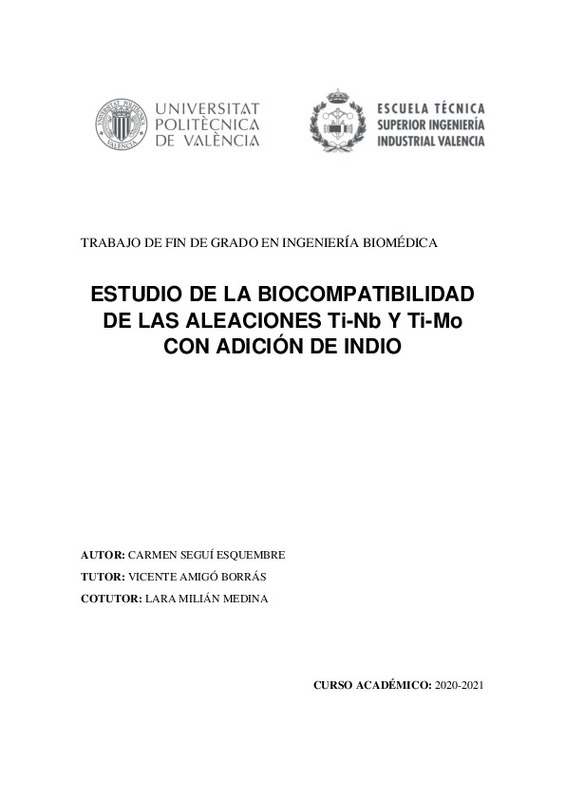|
Resumen:
|
[ES] El titanio y sus aleaciones son los materiales más utilizados en el campo de la biomedicina y odontología para fabricar prótesis, componentes de las prótesis e implantes dentales ya que estos tienen una combinación ...[+]
[ES] El titanio y sus aleaciones son los materiales más utilizados en el campo de la biomedicina y odontología para fabricar prótesis, componentes de las prótesis e implantes dentales ya que estos tienen una combinación favorable de propiedades mecánicas, físicas y químicas. En los últimos años la investigación en las aleaciones de base titanio ha estado en crecimiento constante, convirtiéndose en un sector muy competitivo, para buscar soluciones a los problemas que pueden dar los implantes utilizados actualmente, así como es la enfermedad periimplantaria.
Mediante este trabajo se lleva a cabo la caracterización completa de la aleación Ti-15Mo-5In PM y Ti-35Nb-5In PM. Ambos presentan una estructura hexagonal compacta que permite la reducción de su módulo elástico y el acercamiento de este al del hueso, a diferencia de lo que ocurre con la aleación tan empleada Ti-6Al-4V, con un valor de módulo elástico que dista mucho del del hueso. Además, se realiza también la caracterización microestructural y mecánica de ambas aleaciones para conocer con exactitud sus propiedades. Por otro lado, se realiza en análisis de liberación de iones y el estudio de la resistencia a corrosión de las dos aleaciones en cuestión utilizando saliva artificial como electrolito. Ambas presentaron que se tratan de aleaciones biocompatibles y ninguna presentó ningún efecto tóxico. Además, se utilizaron las salivas con los restos de iones liberados como medio de contacto con las dos líneas celulares: las células madre de pulpa dental humana (hDPSC) y la línea de osteosarcoma humano MG-63. Esto hace posible el análisis de la posible citotoxicidad de estas y se mida el grado de viabilidad celular. Además, se realizan ensayos de diferenciación osteogénica de las células hDPSC y MG-63 para ver si se produce o no la diferenciación de estas en contacto con los discos de las aleaciones Ti-15Mo-5In PM y Ti-35Nb-5In PM.
De este modo se consigue obtener un análisis tanto mecánico como biológico completo de las aleaciones ternarias. Como resultado, se concluye que tanto la aleación aleaciones Ti-15Mo-5In PM y Ti-35Nb-5In PM presentan resultados interesantes en todos los ensayos y también en los ensayos donde se ha utilizado el contacto con las células. Así pues, mediante este trabajo se anima a seguir investigando acerca de estas aleaciones que se consideran muy prometedoras en el campo biomédico.
[-]
[EN] Titanium and its alloys are the most widely used materials in the field of biomedicine and dentistry to manufacture prostheses, components of prostheses and dental implants since they have a favorable combination of ...[+]
[EN] Titanium and its alloys are the most widely used materials in the field of biomedicine and dentistry to manufacture prostheses, components of prostheses and dental implants since they have a favorable combination of mechanical, physical and chemical properties. In recent years, research on titanium-based alloys has been in constant growth, becoming a very competitive sector, to seek solutions to the problems that currently used implants can cause, such as peri-implant disease.
Through this work, the complete characterization of the Ti-15Mo-5In PM and Ti-35Nb-5In PM alloy is carried out. Both present a compact hexagonal structure that allows the reduction of their elastic modulus and its approach to that of bone, unlike what happens with the widely used Ti-6Al-4V alloy, with an elastic modulus value that is far from that of the bone. In addition, the microstructural and mechanical characterization of both alloys is also carried out to know exactly their properties. On the other hand, an ion release analysis and a study of the corrosion resistance of the two alloys in question was performed using artificial saliva as electrolyte. Both presented that they are biocompatible alloys and neither presented any toxic effect. In addition, saliva with the released ion remains were used as a means of contact with the two cell lines: human dental pulp stem cells (hDPSC) and the human osteosarcoma line MG-63. This makes possible the analysis of the possible cytotoxicity of these and the degree of cell viability is measured. In addition, osteogenic differentiation assays of hDPSC and MG-63 cells are carried out to see whether or not their differentiation occurs in contact with the discs of the Ti-15Mo-5In PM and Ti-35Nb-5In PM alloys.
In this way it is possible to obtain a complete mechanical and biological analysis of the ternary alloys. As a result, it is concluded that both the alloys Ti-15Mo-5In PM and Ti-35Nb-5In PM present interesting results in all the tests and also in the tests where contact with cells has been used. Thus, this work encourages further research on these alloys that are considered very promising in the biomedical field.
[-]
|







